تاریخ جهان از ماموت تا فیسبوک (۱)
World history from mammoth to Facebook
World history from mammoth to Facebook
موضوعی که از اولین روز ماه رمضان شروع میکنم و تا هر جا بِکِشم (دوام آورم) ادامه خواهم داد، آشنایی مقدماتی با سرفصلها و نقاط عطف تاریخ جهان به زبان انگلیسی است، برای آن دسته از فرزندان میهنم که نمیتوانند فارسی بخوانند هرچند بیشتر آنها وقتی میشنوند میفهمند.
(توضیحات کوتاهی هم به فارسی اضافه میکنم. مباحث تاریخ جهان دادگاه جهان است نیز بهصورت ویدئو در سایت خودم و یوتیوب موجود است.)
...
منبع مورد استفاده من مقالات پیتر کریسپ، جوفولمن و سوزان کندی است که تاریخ جهان را از سرآغاز تا عصر کنونی بررسی کردهاند.
یادآوری کنم که مباحث تاریخی بر خلاف علوم دقیقه (علوم سخت) Hard science و ثابتها در فیزیک و ریاضی، با امّا و اگر و تفسیر به رأی همراه است، با همه این اوصاف، باید بر لب جوی تاریخ بنشینیم و از آن بیاموزیم. بخصوص که مرتجعین کهنه و نو از ناآشنایی ما با وقایع تاریخی، سوءاستفاده میکنند.
توجه داشته باشیم که هر تاریخ واقعی، تاریخ معاصر است. یعنی فهمیدن ما با واقعیت کنونی همنشین شده و از آن تأثیر میگیرد. از همین رو «تاریخ بی طرف» وجود ندارد و ذهنّیت مورخ گاه مقّدم بر واقعیتهایی است که در اسناد و مدارک یافت میشود.
ــــــــــــــــــــــــــــــــــــــــــــــ
داستان انسان به بیش از شش میلیون سال پیش، در آفریقا برمیگردد زمانی که اجداد میمونگونه ما برای اولین بار شروع کردند با قامت راست راه بروند. راه رفتن روی دوپا ابتداییترین انطباق در دودمان انسانتباران است.
آنان با گذشت زمان تکامل یافته و به آگاهی بیشتر رسیدند و یکی از گونه ها «هومو ارکتوس» (انسان راستقامت)، یاد گرفت که چگونه از آتش و سنگ بعنوان ابزار استفاده کند...(...)
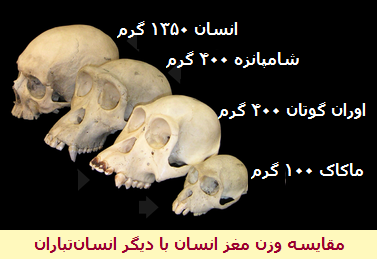
بهرهگیری از ابزارها، خود، نشانهای از هوشمندی است، پژوهشگران بر این باورند که کاربرد ابزار میتواند عامل محرک بخشهای ویژهای از تکامل انسان، به ویژه افزایش ادامه دار حجم مغز، تلقی گردد.
خوب است بدانیم که ما (بشر) متعلق به یک خانواده از میمونهای انسانتبار hominins هستیم که در شرق و جنوب آفریقا تکامل یافته است...(...)
تا بیاید انسان (به لحاظ ریخت و کارکرد) انسان شود ار فراز و نشیبهای بسیار میگذرد. بعد هم کلی طول میکشد تا ابزار بسازد و آتش را کشف کند.
این بحث که ظاهراً به زیستشناسی و داستان فرگشت (تکامل) میماند؛ کم کم روال طبیعی خودش را پیدا کرده، به گذرگاه تاریخ میرسد.
حوصله کنید...
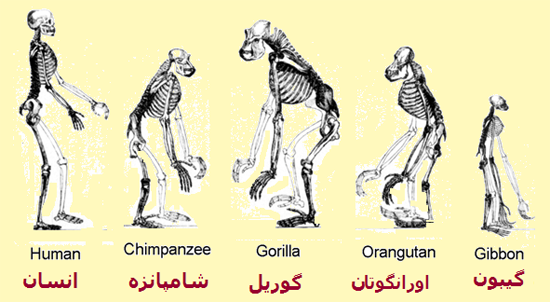
انسانواران به انسان بیشترین شباهت را دارند
کَپی Ape به هر یک از اعضای بالاخانوادهٔ انسانواران Hominoidea اطلاق میشود. نمونههای آشنای آن، گیبون، اورانگوتان، گوریل، شامپانزه و انسان است. (شکل فوق)
به دلیل ابهام در واژهٔ کَپی، بیشتر ترجیح داده میشود از نام علمی هومینوئید Hominoidea (انسانواران) استفاده شود. ویژگی ممتاز جنس انسان در مقایسه با سایر جنسهای دودمان انسان گنجایش بیشتر کاسهٔ سر است. پیشتر ابزارسازی را هم از ویژگیهای ممتاز میدانستند ولی امروز چنین نیست.
6.5 MYA (million years ago) - 3000 BCE
Before history began
The human story began more than six million years ago, in Africa, when our ape ancestors first began to walk upright.
Over time they evolved, becoming bigger and more intelligent, One species, Homo erectus, learned how to use fire and to make ston tools.
They were followed by more advanced species until, around 200,000 years ago, our own species, Homo sapiens, appeared. As hunter-gatherers, modern humans settled every inhabited part of the planet.
Then, around 9500 BCE, humans began to farm, which led to a new way of life.
6.5 / 0.2 MYA (million years ago)
The “cradle of humankind”
Human belong to a family of upright walking apes, called hominins, which evolved in East and South Afica.
We know about hominins thank to their fossils. One of the most important sites is the Olduvai Gorge in Tanzania, where hominin fossils date from around 109 MYA.
The gorge is known as “the cradle of humankind”.
6.5 MYA (million years ago)
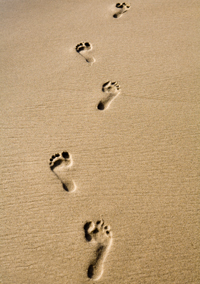
Two-legged ape
The first apes able to walk upright appeared in the forests of Africa. They combined walking with swinging from trees. The earliest evidence so far found is called Sahelanthropus (“Human fossil from Sahel”)
Fossil footprints reveal a species walking on two legs.
3.9 MYA(million years ago)
Human ancestors
A new group of hominins called Australopithecines, spread across the dry grasslands of East and South Africa.
They were small, with brains a third of the size of those of modern humans, but their footprints were much like ours.
2.5 MYA(million years ago)
Early toolmakers
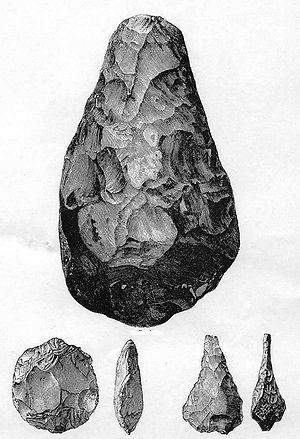 A new hominin species, Homo habilis (handy man), learned how to make stone tools, by striking pebbles with other stones to create a cutting edge.
A new hominin species, Homo habilis (handy man), learned how to make stone tools, by striking pebbles with other stones to create a cutting edge.
They used their tools to dig up roots, open nuts, and smash open bones to get at edible marrow on the inside.
1.9 MYA(million years ago)
Human – sized
Homo erectus (upright man), a descendant of Homo habilis, evolved in East Africa. The discovery of an almost complete skeleton, called the Turksns Boy, showed that Homo erectus was the first hominin to grow as tall as modern humans.
A new tool
Homo erectus invented a new kind of stone tool, the leaf-shaped handaxe, in Africa, around 1.9 MYA.
This was the first tool to be made to a design, and it would remain the main hominin tool for over a million years.
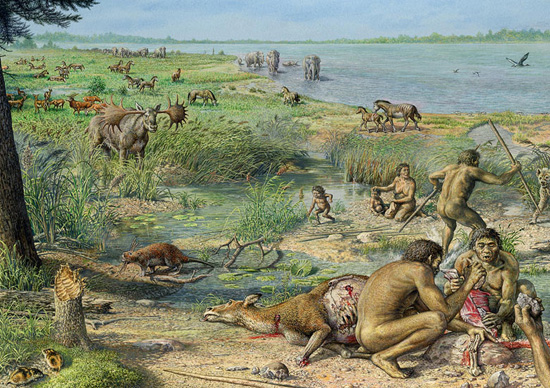
0.5 MYA(million years ago)
First shelters
Descendants of Homo erectus, called Homo heidelbergensis, moved into Europe. where they hunted elephants and hippos with stone-tipped spears. They were the first hominis to build shelters out of wood.
AFRICA
Less than 100,000 years ago, our species, Homo sapiens, moved out of Africa to settle the world. We were not the first hominins to leave Africa. Some 1.9 MYA, Homo erectus moved out of Africa into Eurasia.
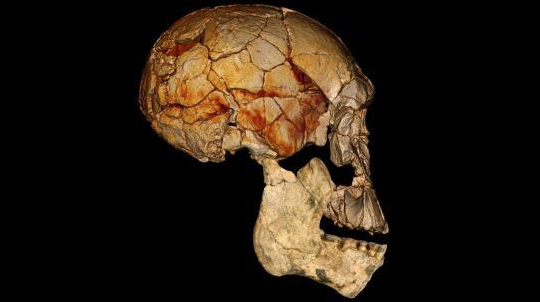
Longest-standing hominin
Homo erectus was the longest - surviving hominin species. They lived across large areas of Africa. southern Europe. Asia, and indonesia for more than 1.5 million years.
Back-sloping forehead. Low brain case, and thick brow ridges
Homo erectus skull from Kenya East Africa
Modern Humans
The first modern humans, called Homo sapiens (thinking man), appeared in Africa 200,000 years ago.
They were larger-brained distinguishing features are a high forehead with slight brow ridges, a small face, and a projecting chin.
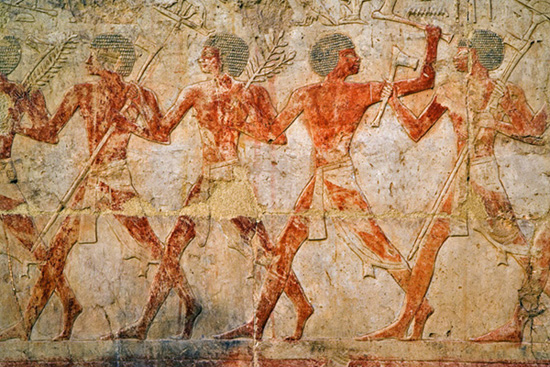
Making fire
Homo erectus learned how to make fire. This provided warmth, light, and protection from wild animals, and was used to cook meat. Fire allowed hominins to move into colder areas of the planet.
پانویس
Cradle of Humankind گهواره بشریت
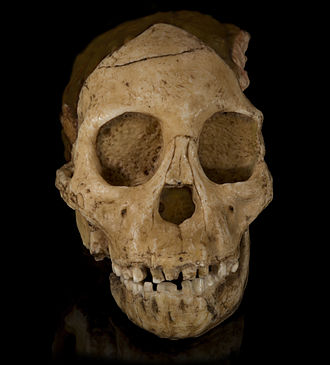 Cradle of Humankind (گهواره بشر) در آفريقای جنوبی در ۵۰ کيلومتری شمال غرب ژوهانسبورگ در استان Gauteng قرار دارد.
Cradle of Humankind (گهواره بشر) در آفريقای جنوبی در ۵۰ کيلومتری شمال غرب ژوهانسبورگ در استان Gauteng قرار دارد.
در سال ۱۹۵۳ برای اولين بار فسيل يک ميمون ۳۰۰۰ ساله در اين محل کشف شد. فسيل انسان به قدمت ۳.۵۰۰.۰۰۰ نیز در اين مجموعه کشف شده است.
...
تنگ اُلدُوای Olduvai Gorge تنگی در شمال تانزانیا است. این تنگ به سبب یافتشدن سنگوارههایی کهن از دودمان انسان در چینههای آن، نزد دیرینمردمشناسان شهرتی بسزا دارد. چنانچه آن را گهوارهٔ بشریت خواندهاند.
...
Sahelanthropus
ساحلمردم چادی با نام علمی Sahelanthropus tchadensis یک گونهٔ انقراضیافتهٔ انسانساییان است که قدمتش به حدود ۷ میلیون سال پیش میرسد. همچنین بقایای اندکی به جز چند تکه از کاسهٔ سر یافت شدهاست
...
سایت همنشین بهار
در همین زمینه







هیچ نظری موجود نیست:
ارسال یک نظر